The first nuclear weapon to go to sea was arguably Little Boy, the bomb dropped on Hiroshima, about half of whose nuclear material was transported to Tinian aboard the heavy cruiser Indianapolis.1 All of the other nuclear components for both bombs were sent to Tinian via air, and while the Crossroads tests gave vital information about the use of nuclear weapons at sea, operational deployment would have to wait another half-decade. The first serious attempt was in the late 40s, as part of the Navy's desperate and ultimately successful bid to break the Air Force's nuclear monopoly. They planned to use Little Boy-type bombs carried by P2V Neptune patrol bombers, a land-based aircraft that was launched from carriers with rocket boosters and ditched at the end of the mission.
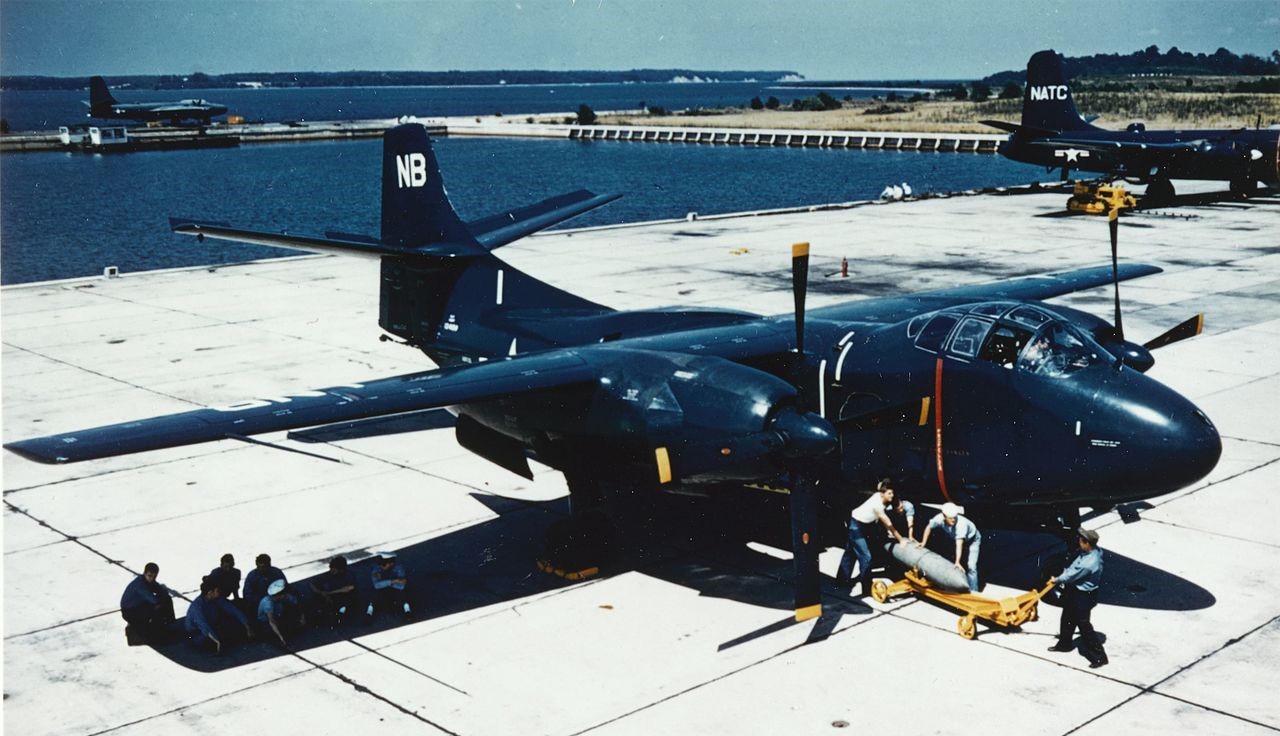
An AJ Savage during the test program
This was obviously a stopgap, and it was never deployed operationally. That honor would fall to the AJ Savage, the result of a competition started days after the existence of the atomic bomb was revealed to the public that called for an aircraft capable of carrying a 10,000 lb bomb off a carrier. The Savage, equipped with two radial engines and a jet buried in the fuselage, was twice the weight of any previous carrier aircraft, but development proceeded fairly quickly, with the first aircraft entering service in 1950. That September, the carrier Coral Sea took the non-nuclear components of several atomic bombs along with her on her deployment to the Mediterranean.
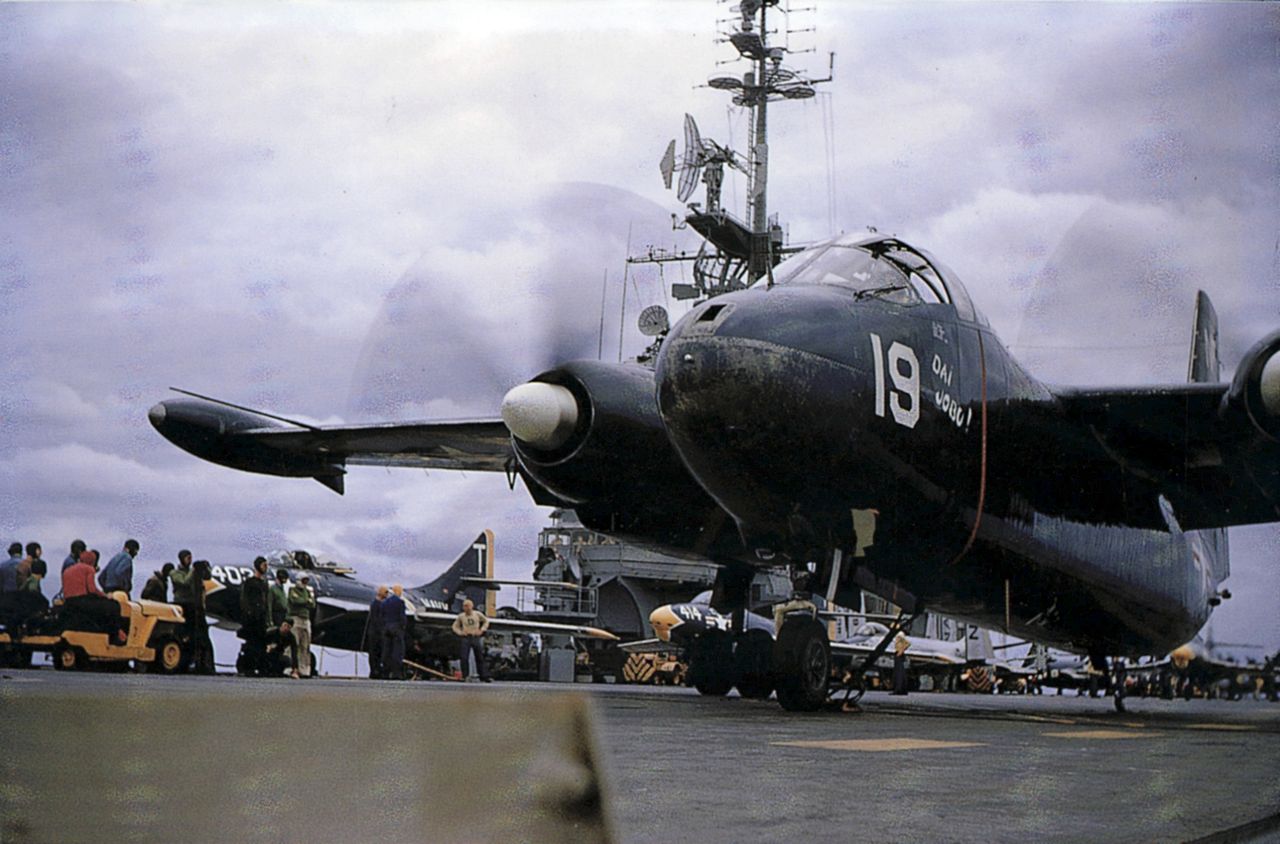
A Savage prepares to launch from Midway
The size of the Savage and the limited American arsenal of fissionable material led to a rather odd operational pattern. The Savages would deploy to Port Lyautey, Morocco, while the carrier was in the Med, as they were too big for even the Midways to operate normally. If needed, the nuclear components would be flown into Port Lyautey, then taken to the carriers by the Savages. Onboard, the Mk 4 bombs would be assembled, and the Savages would then fly back aboard to be loaded with them and onto the target. In 1953, the increasing size of the US arsenal allowed the nuclear components to be deployed aboard the carriers, although the Savages continued to be based ashore. In operation, the Savage was not a popular aircraft. The rush to get it into service had made it unreliable, while it massively disrupted the operations of the straight-deck carriers it flew from. One particular problem was the wing-folding mechanism, which required the hinges to be attached manually to save weight. But something better was on the way.
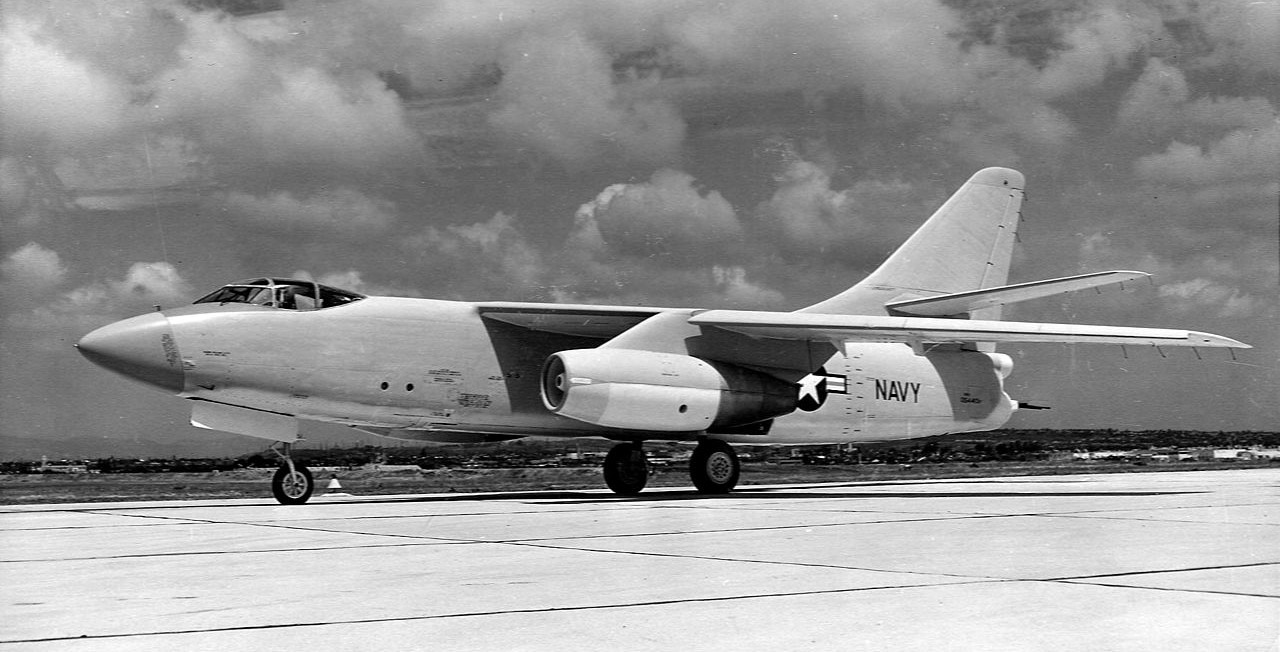
An early A3D-1 Skywarrior with a tail turret, deleted on most models
It came from the desk of legendary aircraft designer Ed Heinemann. The Navy's requirements, issued in 1948, were for an aircraft weighing no more than 100,000 lbs capable of carrying a 10,000 lb weapon 2,000 miles to a target and then returning to the carrier. The high takeoff weight would restrict the bomber to the new heavy attack carriers like United States, which had not yet been cancelled. Most aircraft companies thought it was impossible to meet even these standards, but Heinemann, thanks to careful control of weight, brought in a design that weighed only 68,000 lbs and was capable of operating from the Midways. Most people didn't believe he could do it, but the Navy issued development contracts to both Douglas and Curtiss-Wright. When the dust settled, Heinemann had satisfied them with his 68,000 lb design, while Curtiss-Wright had failed on 100,000 lb.2 The resulting aircraft was the A3D Skywarrior,3 and despite problems with the original J40 engines, a switch to J57s saved the program, and it entered service in 1956, qualified for weights up to 84,000 lbs. Testing of this capability set a record for carrier operation weight that stands to this day, and the Navy even managed to fit the Skywarrior onto the much smaller Essex class carriers. The Skywarrior could carry a whole range of weapons, everything from early bombs like the Mk 5 to Cold War stalwarts like the B28.
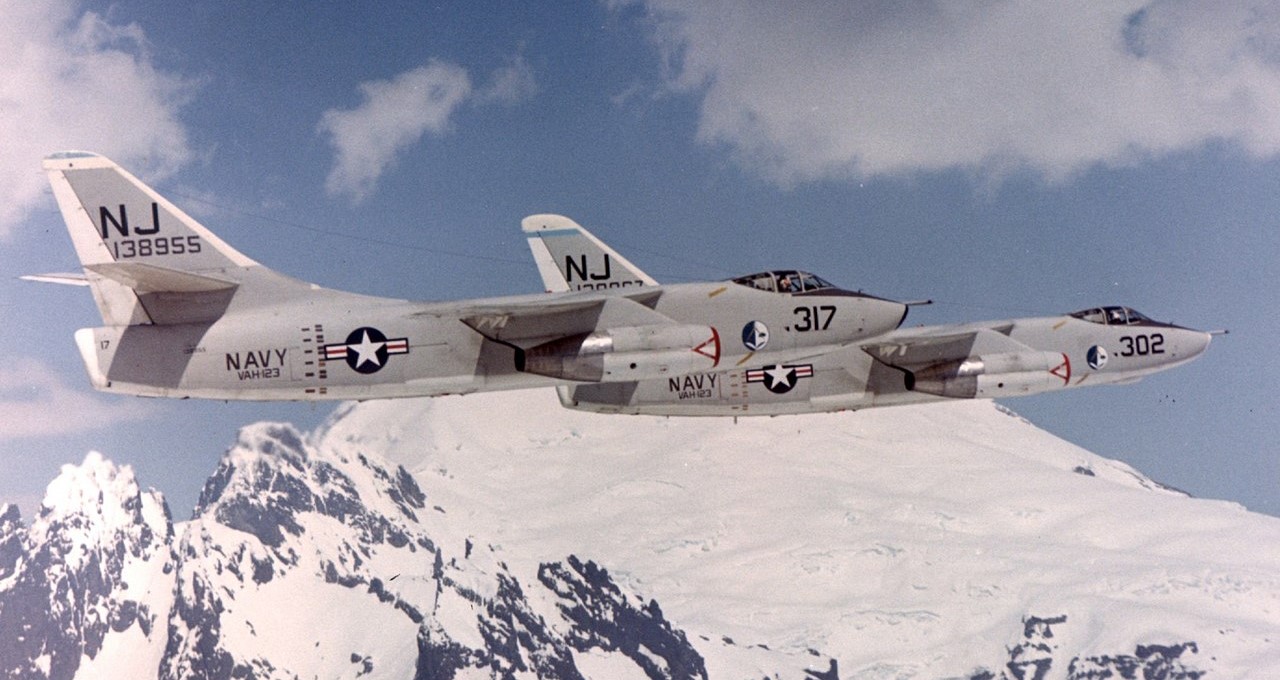
A3D-2 Skywarriors in flight
The time between the introduction of the Savage and the Skywarrior saw major changes in carrier aviation. The angled deck and steam catapult greatly improved deck handling and allowed the Skywarrior to become a standard part of the carrier wing, although it was too big to be struck down in the hangars of any carrier before Forrestal. By this point, increases in the number of available nuclear weapons allowed a shift in focus away from only strategic targets and towards battlefield use of the weapons. The Navy's primary responsibility was to hit tactical targets such as airfields and naval bases, which would also help dilute Soviet air defenses by multiplying the number of directions they had to cover. During this era, the needs of nuclear war had a major influence on carrier operations. Carriers in forward areas often kept an armed and fueled nuclear bomber on the catapult, ready to go at a moment's notice, and the need to support the strike plans greatly restricted their operational flexibility.
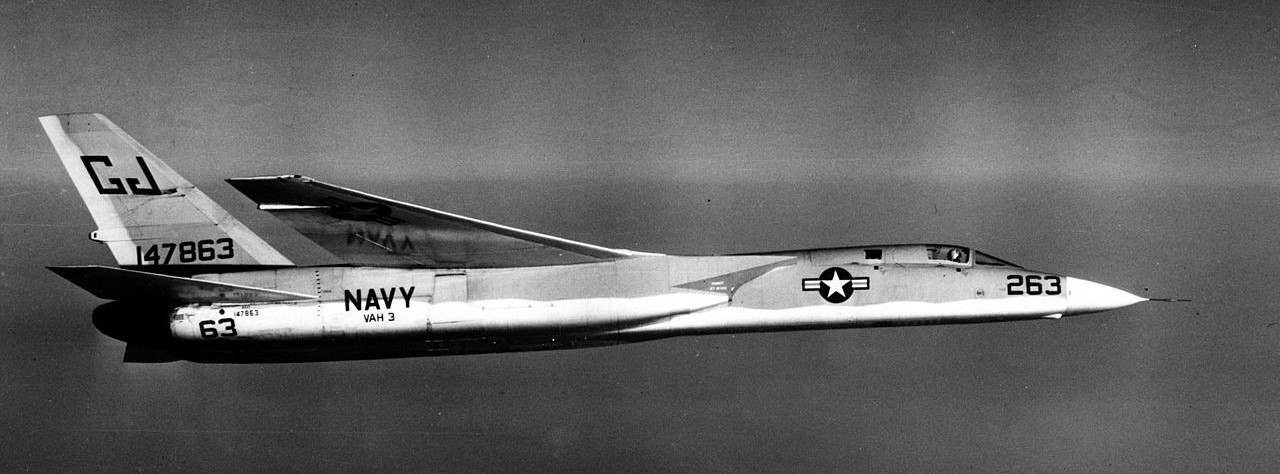
An A3J-1 Vigilante in flight
Even as the Skywarrior entered service, emphasis had begun to shift towards missiles, and the last of the heavy attack bombers originated with North American, not the Navy. The A3J Vigilante4 entered service in 1961. It was an extraordinarily sophisticated aircraft, capable of Mach 2, although it wasn't particularly successful in service. One of the problems was the unique linear bomb bay, which stored the weapon and a pair of fuel tanks between the engines and ejected the whole stack out the back when over the target. In practice, this didn't work well. Assuming the "train" didn't end up sitting on the carrier's deck after the catapult shot, aerodynamic problems meant that the aircraft was unable to achieve anything like the required accuracy.
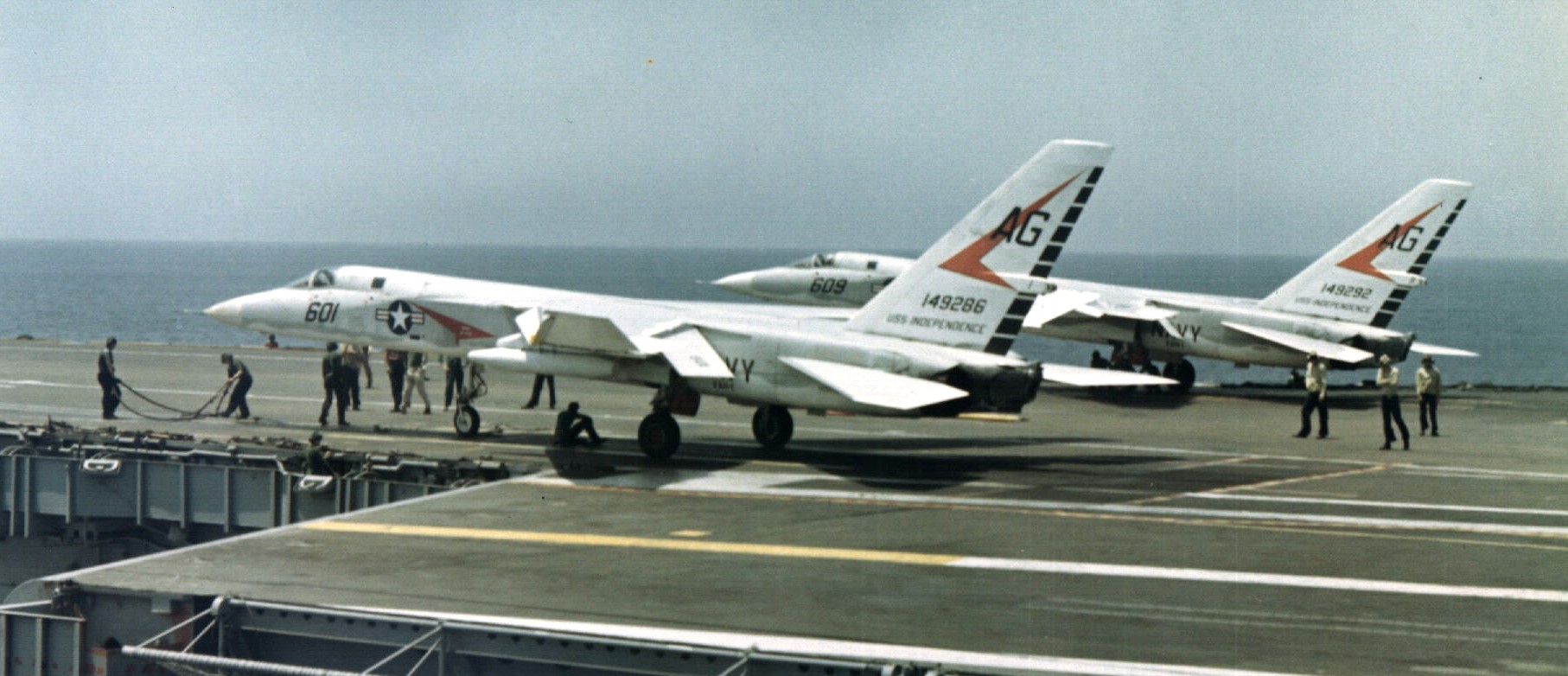
Vigilanties on catapult alert aboard Saratoga
As the 50s wound down and American strategy shifted from massive retaliation, emphasizing the early use of nuclear weapons, and towards flexible response, with its focus on conventional forces, the limitations imposed on the carriers by the focus on nuclear attack became less acceptable. The size and weight of nuclear weapons had fallen sharply throughout the decade, and most naval aircraft were now capable of delivering them. The only area where the heavy attack aircraft still reigned supreme was range, and the Navy solved this by shifting the deep strike role from aircraft to missiles, first the ship- and submarine-launched Regulus, and later the Polaris submarine-launched ballistic missile.
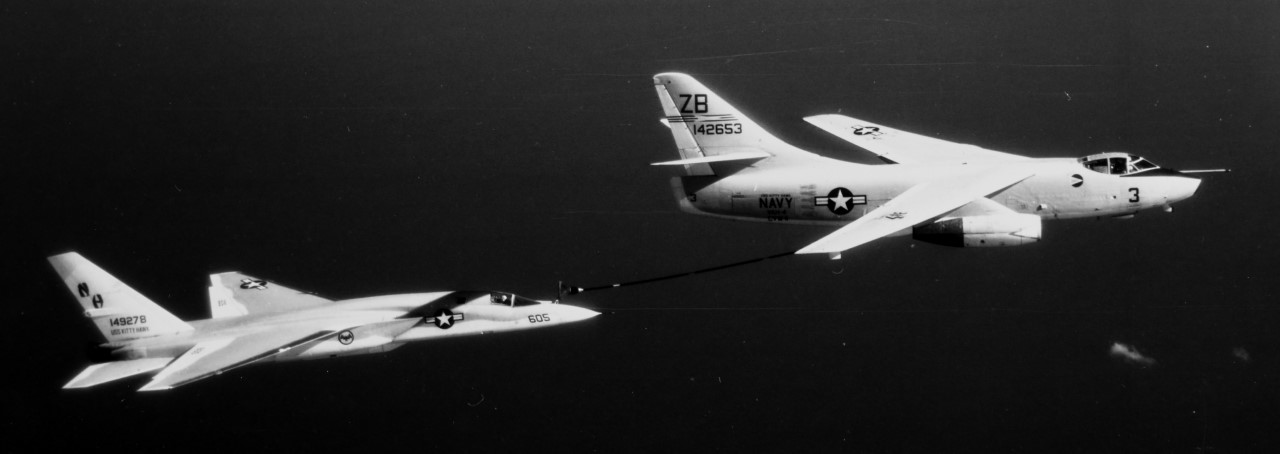
A KA-3 Skywarrior refuels an RA-5C Vigilante
This spelled the end of the heavy attack aircraft, and of the carrier's strategic role in US nuclear war plans. In 1964, most of the squadrons were converted to reconnaissance duties, as were the Vigilantes themselves. The RA-5C was a success in this role, so much so that production was restarted in 1968 to replace losses over Vietnam, and it remained in the US inventory until 1979. The Skywarriors also found new roles as tankers and electronic warfare aircraft, staying in service until 1991. In 1976, the carriers were withdrawn from SIOP,5 although they continued to carry nuclear weapons until 1991, for use by their tactical aircraft. We'll take a look at those next time.
1 Yes, this was indeed followed by the famous incident where Indianpolis was sunk on her way to the Philippines after dropping these components off. For a variety of reasons, it took the Navy four days to notice, during which time about 500 men who survived the sinking died of dehydration, starvation, and shark attack. There have been a lot of books written on this, and I'm sure you can find a few in the local library, so I won't cover it more here. I once saw a library where the entire naval section was two books on this. I was not pleased. ⇑
2 This was apparently the last aircraft competition Curtiss-Wright ever entered. ⇑
3 Also known as the A-3 Skywarrior, as a result of the redesignation of naval aircraft in 1962 into the tri-service system. ⇑
4 Later the A-5 Vigilante. ⇑
5 Single Integrated Operational Plan, the US joint nuclear war plan. This was in fact a fairly late development, only being formulated in 1961. Before that, the services did their own nuclear targeting, often resulting in a given building being hit by one Navy and three Air Force weapons. ⇑

Comments
How did the Savage's turbojet breathe? I took a look at a fair number of AJ Savage photos on Google Image Search, and there is a distinct lack of apparent air intakes along the sides of the fuselage.
Wikipedia says it's on top of the fuselage and normally closed to minimise drag.
The jet engine was only used for takeoff and when operating near its top speed.
The only photo I've found that might show the engine is this one. Unfortunately, most of the launch photos are from below, not from above.
Oh, I see. The engine wasn't in operation all the time, but was really more of a permanently attached JATO booster that allowed the plane to take off from a carrier's flight deck.
And improved speed over the target. There were a couple of similar planes that attempted to combine jet performance with prop range. The Ryan FR Fireball springs to mind.
This and to a lesser degree this seem to imply that the P2V-3C was deployed operationally, for some sloppy value of "operationally". With the bombs ashore at Port Lyautey for the mixed P2V/AJ fleet of VC-5. N.b. the second reference includes a link to the lyrics of "The AJ song".
Prop / turbojet combos (where the jet burned avgas) were a fairly common solution to better speed over target (and/or improved takeoff runs) on 1950s era bombers and MPAs, e.g. B-36D et seq, P4M, later P2Vs (-5F and later), P-2J, final Avro Shackleton (MR.Mk.3 Phase 3), also tankers (for speed matching during refueling) and transports (C-119 and C-123, Nord Nordatlas, probably others I'm forgetting.
FR-1 Fireball is the only operational carrier qualified example I can think of. The Breguet Vultur (early postwar French carrier attack plane, ancestor of the Alize ASW plane) had a turboprop/turbojet combo, mostly for takeoff but also on target dash, but never took off from a real carrier ("This second prototype underwent with success a complete testing program of simulated carrier operations, with catapult-assisted take off and arrested landing, at the Royal Aircraft Establishment, Farnborough, England under the control of the British Ministry of Supply.")
I knew about that, but was using a strict value of operationally ("was it aboard a carrier for actual use"). Handling the P2V-3C was hard in this post, because I'd discussed it quite a bit in Revolt of the Admirals Part 1, and didn't want to repeat a bunch of stuff. A couple of things that the first link missed, by the way. First, when Johnson rode the P2V-3C, the pilot made a crack about an engine failure giving the Navy a flush-deck carrier after all (just after United States was cancelled). Second, according to one of my books, the problem with the carrier landings wasn't the inherent weakness of the Neptune's structure, it was that when a non-carrier-qualified pilot tried to do an arrested landing, he messed it up and did enough damage to the plane to kill the idea off.
Holy smoke, but that Vigilante was a beautiful beast.
The sixth photo down is captioned as Vigilantes aboard USS Saratoga, but the aircraft pictured are from USS Independence. They could be cross-decking; the ship in the photo is clearly a Forrestal-class, but I don't see anything other than the aircraft markings to suggest which one.
You're correct. The photo is this one and it says that they were assigned to Independence and cross-decking to Saratoga.